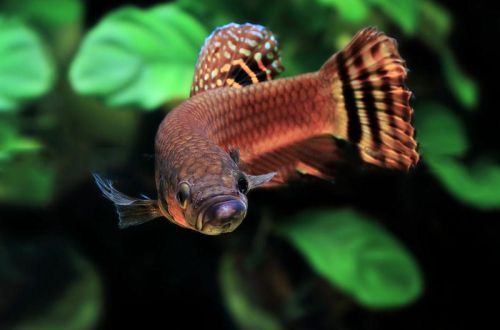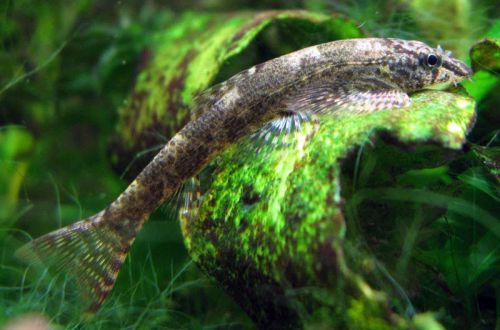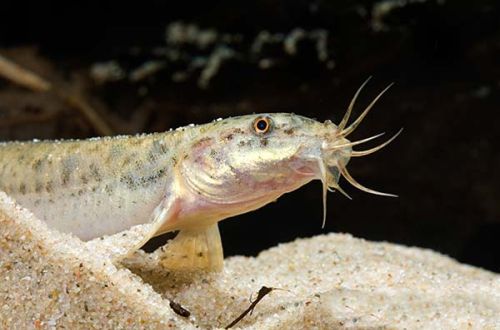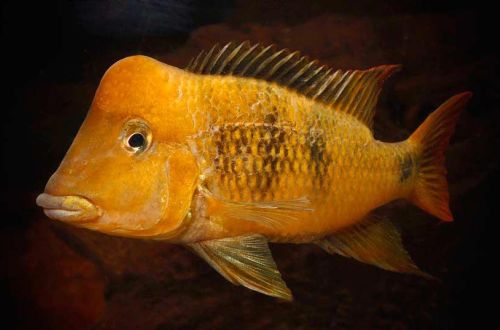
“Brunei Beauty”
The Brunei Beauty cockerel, scientific name Betta macrostoma, belongs to the Osphronemidae family. A temperamental bright fish that attracts not only with its appearance, but also with its behavior. In a spacious aquarium, males and females arrange “fights” to establish a hierarchy, for which they were assigned to the group of fighting fish. It is worth noting that in a small tank such skirmishes can lead to sad results for a weak individual.

Contents
Habitat
It comes from Southeast Asia from the island of Borneo (Kalimantan) from a limited area of the northern regions of the Malaysian state of Sarawak and the border state of Brunei Darussalam. A small natural habitat is actively influenced by human activities, which has led to a significant reduction in the population. Currently, the fish is in the Red Book as a species that is on the verge of extinction. The Sultan of Brunei banned the catching and export of endangered animals, however, in neighboring Sarawak, such laws have not been adopted, so sometimes wild specimens appear on sale.
Inhabits the upper sections of small fast-flowing streams and rivers with clear water, flowing among tropical rainforests. Because of the dense canopy of the trees, little light penetrates right up to the water, from which a constant twilight is preserved there. The bottom consists of rocky sandy substrates with a small amount of plant organic matter (leaves, twigs, etc.). Aquatic plants grow mainly along the coast.
Brief information:
- The volume of the aquarium – from 80 liters.
- Temperature – 20-25°C
- Value pH — 4.0–6.0
- Water hardness – 0–5 dGH
- Substrate type – any dark
- Lighting – subdued
- Brackish water – no
- Water movement – little or no
- The size of the fish is 9–10 cm.
- Food – any food
- Temperament – conditionally peaceful
- Content – in a small aquarium singly or in a pair of male / female
Description
Adults reach 9-10 cm. Males are larger and have a bright red color with black ornaments on the head and fins, the edges and tips of the latter have a white border. The females look different. Their coloration is not replete with colors, the main color is gray with barely noticeable horizontal stripes stretching from head to tail.
Food
In nature, it feeds on small invertebrates, zooplankton and freshwater shrimp. Newly exported fish may refuse alternative foods, but acclimatized or wild offspring will gladly accept dry, frozen, live foods that are popular in the aquarium trade. It is recommended to use special food designed for Betta fighting fish.
Maintenance and care, arrangement of the aquarium
The optimal size of the aquarium for one or two fish starts from 80 liters. When keeping the Brunei Beauty Cockerel, it is necessary to recreate conditions similar to those in which the fish lives in nature. The design uses gravel or sandy soil, natural processed snags, shade-loving plants of the genus Cryptocoryne, Thailand fern, Java moss, Bucephalandra and others.
A good addition would be the leaves of some trees, previously soaked and placed at the bottom. The leaves are not only an element of decoration, but also serve as a means of giving the water a composition characteristic of the natural habitat of this species, due to the release of tannins during decomposition. Read more in the article “Which tree leaves can be used in an aquarium.”
High water quality depends on the smooth operation of the equipment, primarily the filtration system, as well as on the regularity of the obligatory maintenance procedures for the aquarium. The latter include weekly replacement of part of the water with fresh water with the same pH, GH and temperature values, timely removal of organic waste (feed residues, excrement) and other less significant procedures.
Behavior and Compatibility
Very temperamental fish. Intraspecific relationships are built on the dominance of the alpha male over subdominant individuals, which are established in the process of struggle, often resulting in peculiar battles. Even between females there is a hierarchy, and sometimes they have skirmishes between them. In a small aquarium, it is worth keeping only one pair of female and female.
No aggressive behavior was noted in relation to other types of aggressive behavior. Moreover, large and active fish themselves can intimidate and force the Cockers out of the feeder. Compatible with peaceful species of comparable size.
Breeding / breeding
The main difficulty with breeding is related to finding a suitable pair. For example, if you buy a male and a female in different places and settle together, then peaceful coexistence is unlikely to work. In some cases, a weaker individual may even die. The fish should grow together so that this problem does not arise with the onset of the mating season. Spawning is preceded by lengthy courtship, during which the male and female perform a kind of “embrace dance”, closely clinging to each other. At this moment, the eggs are fertilized, which the male immediately takes into his mouth, where they will be for the entire incubation period, lasting from 14 to 35 days. The hatched fry are quite large (about 5 mm) and are already capable of accepting microfeeds such as Artemia nauplii or specialized products for aquarium fish juveniles.
Fish diseases
The cause of most diseases is unsuitable conditions of detention. A stable habitat will be the key to successful keeping. In the event of symptoms of the disease, first of all, the quality of the water should be checked and, if deviations are found, measures should be taken to correct the situation. If symptoms persist or even worsen, medical treatment will be required. Read more about symptoms and treatments in the Aquarium Fish Diseases section.





